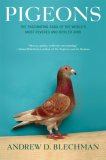Summary | Excerpt | Reviews | Beyond the Book | Readalikes | Genres & Themes | Author Bio

Critics' Opinion:
Readers' Opinion:
First Published:
Oct 2006, 256 pages
Paperback:
Oct 2007, 256 pages
 Book Reviewed by:
Book Reviewed by:
BookBrowse Review Team
Buy This Book
Athletic prowess aside, Columba livia is also an inexplicably
obliging bird and incredibly easy to domesticate.
If you hold one in your hands, it won’t struggle or
bite. And if you let one go, it will always return home. It
is these qualities that have led to the rock dove’s unique
and unrivaled relationship with humans, making it the
world’s first domesticated bird.
Cultural reminders of this connection are abundant.
The bird’s holographic form graces many of our
credit cards. Its outline is used to sell soap, chocolate,
greeting cards, and world peace. Rock doves have graced
films: Marlon Brando found solace caring for them in On
the Waterfront, and “Mr. Smith” even brought his pigeons
with him to Washington. For years, dramatically
circling pigeons were a celebrated attraction at Walt Disney
World. Picasso painted them frequently and named his
daughter Paloma - Spanish for pigeon.
The rock dove has been our companion for thousands
of years. Like most birds, the pigeon is basically a
feathered reptilian dinosaur and has roamed the earth in
one form or another for over 30 million years. By comparison,
we’ve been walking about for a mere 130,000
years.
As a particularly successful species, the rock dove
has come to populate every continent on earth, with the
exception of Antarctica. In the early 1600s, French settlers
imported the rock dove to the New World for meat.
Now they populate nearly every city in the Western Hemisphere,
from the arid deserts of Arizona to the frigid climes
of Alaska. The pigeon does not migrate but rather adapts
to its chosen location year-round.
Fossil evidence suggests that the pigeon originated
in southern Asia and made its way across northern Africa
and Europe, much like the Muslim conquerors and the
Mongol hordes of yore. Skeletal remains found in Israel
confirm the rock dove’s existence there for at least three
hundred thousand years.
When did human fascination with the pigeon arise?
Most likely with our earliest days as cavemen. Although
the rock dove generally prefers sea cliffs with protective
ledges, it probably made itself at home in the outer nooks
and crannies of our shallow caves and then scavenged for
our crumbs. It’s also quite likely that humans ate the tasty
little bird whenever possible.
This somewhat symbiotic relationship progressed
along with human civilization. As we learned to domesticate
grains and cereals, we inadvertently domesticated the
pigeon as well. As any farmer knows, a small portion of
every crop never makes it to the granary. Rather, bits and
pieces of it spill to the ground during harvest. These leftovers
make for easy pigeon pickings. Crevices in our mud
and stone farmhouses also made for good nesting places. It
could be said that the pigeon domesticated itself and humans
merely met it halfway, often with a healthy appetite.
Research suggests that the pigeon was domesticated
perhaps as early as ten thousand years ago, not long after
we tamed our other “best friend,” the dog. While the bird
remains somewhat cautious, it is inherently unafraid of
humans. As anyone who has befriended a pigeon will tell
you, it doesn’t take much effort to train the bird to eat out
of your hand. In fact, a pigeon will happily walk through
your front door if it knows there is birdseed inside. Conversely,
given that pigeons can be bred all year long and
are naturally docile, they were ideally suited to become a
domesticated food source.
Eventually, early humans built homes for their pigeons,
called dovecotes, and harvested the bird for food
on a regular basis. They were crude structures at first, but
by the late Middle Ages, dovecotes were built with great
architectural flourish. Thousands of these spectacular dovecotes
still dot the European countryside, often attached to
country manor houses and estates.
Excerpted from Pigeons © 2006 by Andrew Blechman, and reprinted with the permission of the publisher, Grove Press.





The Flower Sisters
by Michelle Collins Anderson
From the new Fannie Flagg of the Ozarks, a richly-woven story of family, forgiveness, and reinvention.

The House on Biscayne Bay
by Chanel Cleeton
As death stalks a gothic mansion in Miami, the lives of two women intertwine as the past and present collide.

The Funeral Cryer by Wenyan Lu
Debut novelist Wenyan Lu brings us this witty yet profound story about one woman's midlife reawakening in contemporary rural China.
Your guide toexceptional books
BookBrowse seeks out and recommends the best in contemporary fiction and nonfiction—books that not only engage and entertain but also deepen our understanding of ourselves and the world around us.